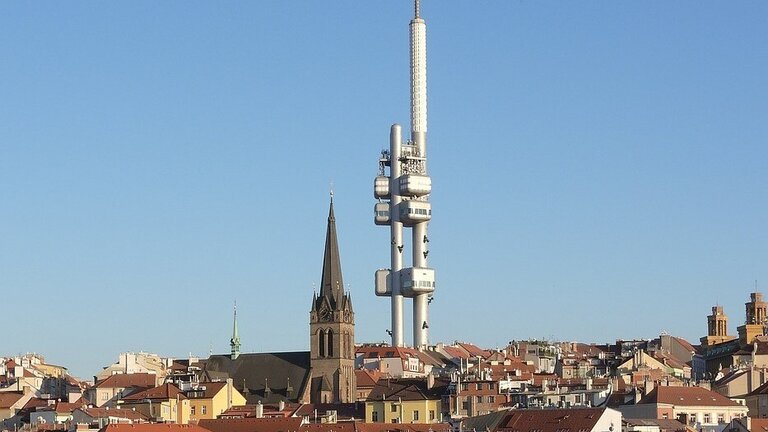Further, only one of them, the western one, passes into the antenna extension, nicknamed “a corn cob”. In the western tube there are also two fast lifts for passenger transport – the fire escape of the tower leads to a height of 124 m and is intended only for emergency operation, in the northern tube there is a freight elevator.
The tubes carry three cabins: at a height of 66 m there is a restaurant, at a height of 93 m there is an observation cabin (from which it is possible to see up to 100 km away, in good visibility) and a little higher is a broadcasting cabin. Above, there are platforms with lattice masts and constructures for attaching antennas, because the tower is also an important telecommunication node: besides digital broadcasting of 11 television and 8 radio stations (analogue television broadcasting was finally finished three years ago) there are mobile transmitters, VHF radio transmitters and other wireless links.
In January 2011, after almost 20 years of operation, the adaptation of the tower interior began. A panoramic restaurant, a café and a wine bar were opened in the lowest cabin, and a hotel suite with a unique view was added later. Part of the adaptation is the reconstruction of air-conditioning units, also because of the layout changes in the kitchen. The air handling unit had to be moved, increased its output and moved its control cabinet together with it.
The BMS is provided by Domat IPLC freely programmable DDC controller and distributed I/O modules, which are located in the HVAC engine rooms in four switchboards along with high-current circuits, all at the restaurant cabin level, on the floor just above the restaurant on the 6th floor. The system is operated either directly from the switchboard or from a SCADA on the computer in the reception. Thanks to the network topology, the system can be accessed from anywhere via a web browser.
The building control system contains 130 physical data points. By physical data point we mean one input or output of the control system, i.e. a temperature sensor, relay for switching a motor, an output for positioning the valve etc. Sometimes the range of a system is evaluated by the number of all variables, both physical and virtual data points (virtual values include setpoints, time programs and their states, heating curve parameters, etc., i.e. all internal variables that the system or user can access); more often, only inputs and outputs, or physical data points, are counted. So however the system is small in size, the building whose technology it controls does not appear in the projects every day. For comparison: a family house usually contains 20 – 30 data points, a shopping center up to 1000, large multifunctional buildings with integration of other systems, individual room regulation, etc. up to 10 000 – 15 000 data points.
Air handling units Restaurant 1, Restaurant 2 and Lounge are equipped with heating and cooling, rotary heat exchanger and fans, controlled by VSDs. There is a heater on the supply air side to the sill units, which is regulated to the supply temperature. The fan speed and unit operation according to the time program can be adjusted from the room controllers. Differential pressure switches monitor filter clogging, fan failure and increased pressure drop of the heat exchanger (anti-freezing measures along with temperature monitoring at the heat exchanger output). The inlet and outlet dampers of the unit have also emergency function. The same applies to the air-conditioning units for the apartment and kitchen, where the heater is not installed. Another five smaller air-handling units are fitted with their own controls, without link to the BMS.
The entire construction is subject to extremely high demands on fire safety. The air ducts in the central part of the cabin on the 6th floor, which in the original version were made of sheet metal with fire-protection spraying, are now composed of Grenamat boards (a mixture of expanded vermiculite and a special inorganic binder). In the ceilings of the restaurant there is already used classic metal piping with flexible piping and metal diffusers. The ventilation systems are equipped with fire dampers, the fire protection signal also blocks operation of all units on a hardware basis.
The cabins are basically glazed from all sides for visibility. The windows are double-layered and to prevent condensation in the space between the windows, the above-mentioned window sill units are installed under all windows, and blow the inside of the windows. In the ventilated common areas there is also an electric floor heating, which is controlled to the room temperature.
The heat for air-conditioning units is provided by electric boilers located in the air-conditioning engine rooms. Four cooling units are installed on the roof of the 6th floor of the tower (above the restaurant), so they do not affect the appearance of the building. Each unit has a shutter in case it is out of service; all units are connected to a common storage tank to stabilize the system and reduce the number of unit starts when the system is not fully loaded.
Certainly, an attractive part of the newly renovated space is the hotel suite, with a heating cable and temperature sensor installed in the ceiling. This system is intended to prevent water condensation on the structure at low outdoor temperatures: under the assumed conditions of the apartment at 21.5 °C and 30 %rH, the heating cables will start when the outdoor temperature falls below 0 °C. Even in extreme conditions (design temperature –14 °C), the surface temperature of the structure should not fall below 7.5 °C.
In addition to the adapted premises of the restaurant, visitors have been welcomed after the reconstruction since June 2012 also in a new garden restaurant. The Mahler Square had become another interesting summer tourist destination.
